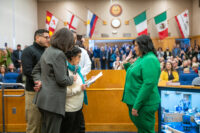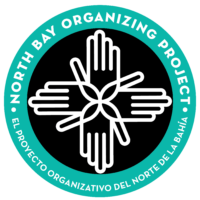
Ryan lely/Sonoma Valley Sun
Kathy Swett walks out of a city council meeting last week after withdrawing a funding request for the Community Center from the city.
Kathy Swett, dressed casually in soft brown pants, a brown cotton sweater and sneakers—“gosh, I look grubby,” she said, mistakenly—sat at a conference table at the Sonoma Community Center, where she is executive director, and talked about the bomb shell she had dropped at the Sept. 10 City Council meeting.
In what clearly was a rare if not unheard of occasion for any local, state or federal agency, the council was informed by someone that taxpayer money—carrying with it few strings or pre-ordained restrictions—was not wanted.
A stunned panel of council members, where a seemingly endless stream of garrulousness is the norm, was suddenly silent.
It had all the earmarks of a well-orchestrated exit scene, a one-upmanship gesture aimed at having the last word in an on-going drama whose end was near, its conclusion obvious and mere minutes away.
Seconds before this denouement David Goodison, president of the Community Center Board of Directors—following his testimony before the City Council stating the importance of the money being asked by the center for center programs—could be seen in the audience huddling with Swett, the center’s executive director.
Then he rose, stepped to the podium and told the council to forget it; the center was breaking with more than 20 years of financial partnership with the city during which it provided numerous services, many of them art-based, to Sonoma residents, many of them children.
It had all the feeling and shock value of an upscale version of the famous line in the classic “Treasure of the Sierra Madre,” “I don’t want no stinkin’ money.”
More than a week later, the fact that it happened still surprises and baffles many.
Community Center officials say the decision had been well thought out and was announced only after it became clear that neither the community center nor some 40 other Sonoma Valley non-profits would be getting the money they had asked for. It exceeded $240,000—which was as much as the city was willing to give for the current fiscal year.
Also at play, said Swett, was the realization that by declining funds, the center could help others in need of funding – that is, the city could use the money that would have gone to the center for other non-profits, particularly one that she said, without identifying it, is in serious financial condition.
“By removing the SCC from what we perceived as a damaging and divisive funding debate,” she e-mailed community center members over the weekend, “we ensure that the other three non-profits will obtain their full funding requests from the city.”
If they do, it may be the last time. The writing, say officials and others familiar with the city’s budgetary process, is on the wall and Sonoma’s unusual if not unique arrangement with non-profits in the Valley soon will be a thing of the past.
In the meantime, Swett said the center would continue to fund and put on the July 4th Parade and the Annual City Party.
She said the center would rely more than ever now on fund-raising and donations to maintain its programs, many of which deal with the arts.
The center, a historical landmark that began as a grammar school, also makes money from renting out rooms, particularly its auditorium, Andrews Hall.
In her e-mail, Swett wrote:
“The Sonoma Community Center has always been a grass-roots, membership-based organization. Today we need to rely on membership more than ever.
“This year could be the center’s best yet…Help us to make this happen!”
For 20 years the city has offered substantial funding first to the community center and then to three other non-profits – the Boys & Girls Club Valley of the Moon, the Vintage House and, new this year, the Ecology Center. About five or six years ago, according to Mayor Stanley Cohen, the city’s budget was more flush than usual and the council provided money for additional non-profits. This year there are more than 40 non-profits seeking money from the city.
There are no specific criteria used to determine which non-profit gets money from the city. Cohen said an effort of his to put specific requirements in place was dismissed out of hand as not the way it was done in Sonoma.
In the Valley, he recalls being told by one council member, “We do it on a feel-good basis.”
The council at the recent meeting approved a total of $240,000 that could be spent on the organizations of which $150,000 would go to the three “Tier One” non-profits plus another 35 or so that will compete for the remaining $90,000.
At work is a desire of the majority of the council and led by Cohen to overhaul the way in which non-profits are funded. For about two decades the top three non-profits have been included in the city’s annual budgets, showing up on paper essentially as departments of the city This was fitting, say some, because the services provided by those particular non-profits are identical to those provided by city departments in other communities.
Cohen and others believe all non-profits should be pulled from the city’s budget and funded by another process, and this is what the council has approved over the summer months.
However, this may be only the beginning. Interviews with city officials suggest that concerns about lean city budgets in the future are fueling thoughts about eliminating all non-profit funding and perhaps going to a parcel tax—the first in the city’s history—sometime in the not-too-distant future to provide the various services expected by Sonoma residents.
City council member Joanne Sanders, a strong supporter of the community center and also among the most worried about its decision to decline city funding, said, “The city is fairly limited in its sources of funding.”
The hotel tax she and others noted brings in more money than it does in other nearby communities both in Sonoma and Marin counties. But it is not enough to sustain the growing expenses associated with overhead, police and fire services and salaries. The city’s current budget is $11 million.
“We might need to build a new hotel,” she said, adding that the addition of a new convention center might be useful in generating an increase in the number of persons visiting Sonoma which in turn would increase the demand for hotel rooms and thus increase hotel tax revenue to the city.
But, she conceded, it may be necessary to go to the voters with a parcel tax proposal, something she clearly would rather avoid, particularly since two other agencies, the Sonoma Valley Unified School District and the Sonoma Valley Health Care Distric have either gone or are soon to go to voters with parcel tax proposals.
“We would be third in line,” she said, which she made clear is not an enviable position.
“But before we go to the voters we are going to be focusing on tightening the belt and doing every thing we can to save money.”
The community center is not completely divorcing itself from the city financially.
It will be seeking city funds for such things as solar heating.
Says the e-mail:
“Since the majority of the City Council no longer supports broad-based cultural and leisure services, the SCC needs to strategically align ourselves with the city in ways which better reflect the council’s new priorities: namely capital improvement projects and one-time program requests.”




